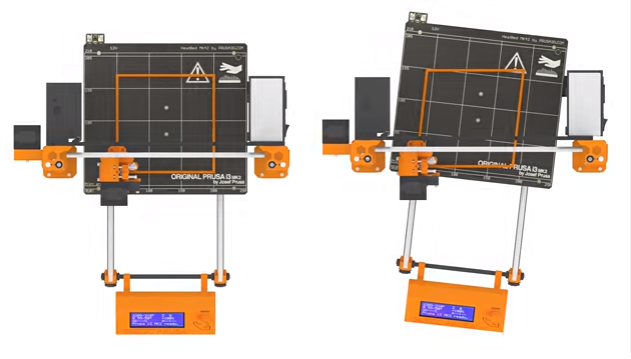Worried Your Assembly Was a Bit Off? The Prusa i3 MK2 Unique Calibrate XYZ Function Offers Perfect 3D Printing Anyway
![]() As Prusa3D founder Josef Průša recently relayed to 3DPrint.com, the original Prusa i3 MK2 3D printer has certainly been well received by makers, but his company continues to improve it. With reviews ranging from raves to very good, this printer has been described so enthusiastically that industry experts have resorted to expletives, with others recommending it as a great 3D printer at a good price—as well as its being compared to the Ultimaker in quality, a comment we would surely view as a valuable compliment.
As Prusa3D founder Josef Průša recently relayed to 3DPrint.com, the original Prusa i3 MK2 3D printer has certainly been well received by makers, but his company continues to improve it. With reviews ranging from raves to very good, this printer has been described so enthusiastically that industry experts have resorted to expletives, with others recommending it as a great 3D printer at a good price—as well as its being compared to the Ultimaker in quality, a comment we would surely view as a valuable compliment.
That wasn’t enough for Prusa3D, though, in the ongoing quest for excellence. They’ve now created a new, unique Calibrate XYZ function for the MK2. What this means for the user is that their kit-built printers can now attain precision and quality comparable to that of a higher end printer. The MK2 is the first to have this capability, determining precision and then automatically correcting itself during the print process for any misalignments that may occur.
“Full mesh bed levelling is also implemented to achieve perfect first layer by copying the precise shape of the print surface,” states the Prusa3D team.
The bottom line, and a rather comforting one certainly, is that no matter how you assembled your printer when building out the kit, ‘the prints will always be perfectly square.’
The printer goes into automation mode searching for all of the calibration points and performing the required calculations. And even if your printer was (ahem!) assembled in a distorted manner, the calibration will still be precise. Prusa3D has taken user error out of your hands here, as well as solving the frustrating exercise that calibration can sometimes become. Check out the video below for step-by-step details regarding the calibration process:
It’s no secret that 3D printing has the potential to be a headache if you don’t choose correctly. User-friendliness is key, as well as a motivating factor in keeping the maker interested in the hardware.
“The problem with the home and prosumer 3D printers lies in the ease of use or more precisely the lack of it,” states the Prusa3D team in their press release. “They are pain to set up before every print and therefore when the initial excitement wears off, the printers collect dust. It is a complex problem of removing the barriers before the print.”
With this new calibration system and the MK2 release, Prusa Research was solving two big problems:
- The print surface is now prep-free, thanks to PEI space material.
- With full mesh-bed leveling, substantial stress is removed on the part of the user, as constant adjustments are no longer required.
“A few printers like the Lulzbot TAZ line introduced automatic bed levelling before, but solutions like this only measure three points and therefore only correct for the angle, but not for the slight imperfections of the flatness every surface has,” states Prusa3D.
The print bed has 3 x 3 special calibration points so that the printer is able to calculate what the distance is between the surface and the print head, generating a high resolution map and allowing the print head to navigate accurately and create a perfect first layer.
“Even the slightest bow or twist of the surface are compensated with ease and user doesn’t have to tweak anything before the print,” states Prusa3D.
The MK2 is being released as a fully assembled and tested model at $899, or as a kit for $699. Prusa Research points out that the kit model is usually the preferred 3D printer chosen by their users, and with the calibration issue solved, they should feel even more comfortable in assembling and attaining precision. You can find out more about the technology here, and also enjoy an updated version of the new user guide below. Discuss this further in the MK2 3D Printer New Calibration forum over at 3DPB.com.
Subscribe to Our Email Newsletter
Stay up-to-date on all the latest news from the 3D printing industry and receive information and offers from third party vendors.
You May Also Like
NSF Awards Kentucky $1M for Advanced Manufacturing
The National Science Foundation has awarded a $1 million grant to the University of Louisville for the Advancing Manufacturing and Building Construction Technologies (NSF AMT) project. This initiative is part...
3D Printing News Briefs, May 11, 2024: 3D Printed Stent, Tower, Sculptures, & More
We’re starting off with medical research in today’s 3D Printing News Briefs, as researchers in Korea used CT images and 3D printing to fabricate an educational simulator for a mastoidectomy....
3D Printing Unpeeled: Wind Turbines, Probiotics and Lenses
TPI Composites, ORNL and Ingersoll Rand are working to make wind turbine tooling segments that can be 18.3 meters long. These elements also include resistive wires that help keep the...
Tethon 3D Releases Cost-effective Bioprinter
Tethon 3D, known for its ceramic-loaded DLP materials, custom resins, and DLP 3D printers, has recently released a bioprinter. Vat polymerization printers like DLP systems have been widely used by...

































